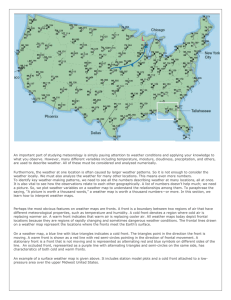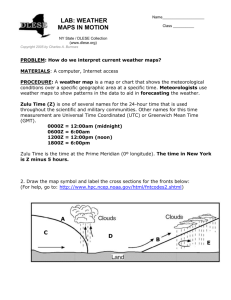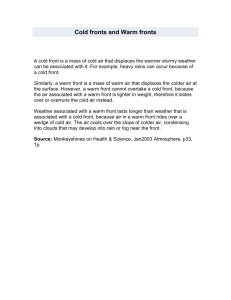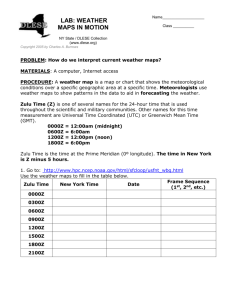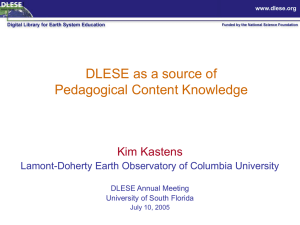Weather Maps Lab: North Carolina - Meteorology Activity
advertisement
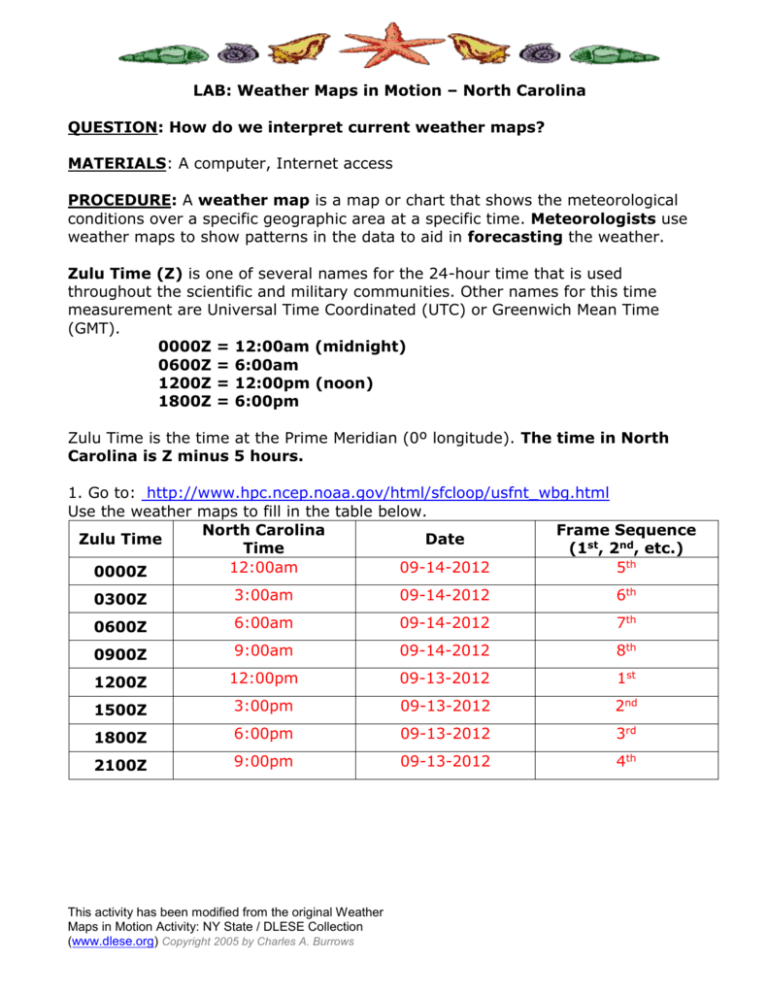
LAB: Weather Maps in Motion – North Carolina QUESTION: How do we interpret current weather maps? MATERIALS: A computer, Internet access PROCEDURE: A weather map is a map or chart that shows the meteorological conditions over a specific geographic area at a specific time. Meteorologists use weather maps to show patterns in the data to aid in forecasting the weather. Zulu Time (Z) is one of several names for the 24-hour time that is used throughout the scientific and military communities. Other names for this time measurement are Universal Time Coordinated (UTC) or Greenwich Mean Time (GMT). 0000Z = 12:00am (midnight) 0600Z = 6:00am 1200Z = 12:00pm (noon) 1800Z = 6:00pm Zulu Time is the time at the Prime Meridian (0º longitude). The time in North Carolina is Z minus 5 hours. 1. Go to: http://www.hpc.ncep.noaa.gov/html/sfcloop/usfnt_wbg.html Use the weather maps to fill in the table below. North Carolina Frame Sequence Zulu Time Date Time (1st, 2nd, etc.) 12:00am 09-14-2012 5th 0000Z 0300Z 3:00am 09-14-2012 6th 0600Z 6:00am 09-14-2012 7th 0900Z 9:00am 09-14-2012 8th 1200Z 12:00pm 09-13-2012 1st 1500Z 3:00pm 09-13-2012 2nd 1800Z 6:00pm 09-13-2012 3rd 2100Z 9:00pm 09-13-2012 4th This activity has been modified from the original Weather Maps in Motion Activity: NY State / DLESE Collection (www.dlese.org) Copyright 2005 by Charles A. Burrows 2. Draw the map symbol and label the cross sections for the fronts below: (For help, go to: http://www.hpc.ncep.noaa.gov/html/fntcodes2.shtml) A C D B C E DRAW FRONT SYMBOL OR CIRCLE ONE LABEL CIRCLE ONE Front A Cold Front / Warm Front Front B Cold Front / Warm Front Air Mass C Cold / Cool / Warm DENSITY: High / Medium / Low Air Mass D Cold / Cool / Warm DENSITY: High / Medium / Low Air Mass E Cold / Cool / Warm DENSITY: High / Medium / Low 3. As a cold front catches up with a warm front, an occluded front forms. What happens to the warm air between the two frontal interfaces? (Circle one.) A) The warm air is forced under the cold frontal interface but over the warm frontal interface. B) The warm air is forced over both frontal interfaces. C) The warm air is forced under both frontal interfaces. D) The warm air is forced under the cold frontal interface but under the warm frontal interface. 4. Draw the map symbol for an occluded front. 5. Look at the weather map loop. Which is faster? a cold front / a warm front This activity has been modified from the original Weather Maps in Motion Activity: NY State / DLESE Collection (www.dlese.org) Copyright 2005 by Charles A. Burrows 6. Pick a cold front and estimate its speed in miles per hour. Show your work below. (Hint: America is about 3,000 miles from coast to coast.) The front we observed moving across the United States traveled approximately 1000 in a 24-hour period. 1000/24 would calculate to a speed of 41.6 miles per hour for the estimated speed of the cold front as it moved across the US. 7. Explain the relationship between the locations of high and low pressure centers and fronts. High-pressure centers are located in front of, or behind, frontal boundaries. Lowpressure centers tend to form along the frontal boundaries. 8. In what general direction do cold fronts move across America? Warm fronts? Cold fronts typically travel from the northwest toward the southeast as they move across the US. Warm fronts typically travel from the southwest toward the northeast. 9. How should the weather change (before, during, after) as a cold front passes by? A warm front? Cold front: Before (warmer); During (windy & stormy); After (clear & colder) Warm front: Before (cooler); During (drizzly rain); After (clear & warmer) 10. In America, which type of front extends southward from a low-pressure center? Eastward? In the US, a cold front extends southward from a low-pressure center and a warm front extends eastward from a low-pressure center. 11. Go to: http://www.hpc.ncep.noaa.gov/html/sfcloop/sfc00.html Find this station in North Carolina on the weather map, and complete the table. This activity has been modified from the original Weather Maps in Motion Activity: NY State / DLESE Collection (www.dlese.org) Copyright 2005 by Charles A. Burrows (For help, go to: http://www.hpc.ncep.noaa.gov/html/stationplot.shtml) Frame Sky Wind Sequence Temperature Dewpoint Pressure Wind Cover Date Time Speed (1st, 2nd, (ºF) (ºF) (mb) Direction (% (kts) etc.) cloudy) th 5 9/14 0000Z 72 64 233 NNE 3-7 0 6th 9/14 7th 9/14 8th 9/14 1st 3-7 0300Z 68 65 231 NNE 0600Z 67 66 223 N 0900Z 68 66 225 NE 9/13 1200Z 79 68 222 NE 0 0 1500Z 83 61 246 NE 3-7 0 1800Z 82 64 250 NE 0 0 2100Z 76 66 252 NE 0 0 2nd 9/13 3rd 9/13 4th 9/13 3-7 3-7 12. A meteogram is a graphical depiction of trends in meteorological variables such as temperature, dew point, wind speed and direction, pressure, etc. The time series meteogram can be constructed using observed data or forecast data. Using the data from the table, complete the meteogram on the next page. For Temperature, Dew Point, Pressure and Wind Speed, make line graphs. For Wind Direction, draw a station model in the box showing where the wind is coming from. Examples: For Sky Cover, draw the proper map symbol in the box. Examples: This activity has been modified from the original Weather Maps in Motion Activity: NY State / DLESE Collection (www.dlese.org) Copyright 2005 by Charles A. Burrows 0 0 0 (SEE WIND DIRECTION AND SKY COVER ON NEXT PAGE) This activity has been modified from the original Weather Maps in Motion Activity: NY State / DLESE Collection (www.dlese.org) Copyright 2005 by Charles A. Burrows Use the information from the North Carolina Station Data Table to record the wind direction and sky cover data below. Example: The wind direction on 9/13 at 12:00zulu was NE and the sky cover was 0%. You need to write the wind direction (such as, NE) in the top box and the % of sky cover in the bottom box below the wind direction for the matching date and time. Be sure to add your date and time information at the bottom of the chart, starting with 12:00zulu on 09/13. This activity has been modified from the original Weather Maps in Motion Activity: NY State / DLESE Collection (www.dlese.org) Copyright 2005 by Charles A. Burrows
